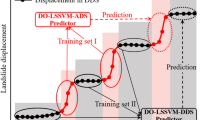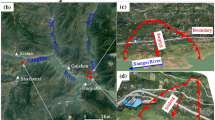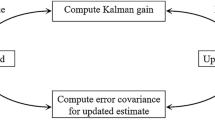Abstract
Constructing an accurate and dependable displacement forecasting model is a prerequisite for realizing effective early warning systems of landslide disasters. To overcome the drawbacks of previous displacement prediction models for landslides with step-like deformation characteristics, such as the low prediction accuracy of the mutational displacements and the unclear reliability of the prediction results, we propose a novel hybrid interval forecasting model. This model consists of four parts. First, clustering by fast search and find of density peaks is implemented to distinguish the deformation states of the landslide. Second, the ensemble classifier based on the random forest algorithm is established to identify the deformation states. Third, based on the wild bootstrap, kernel extreme learning machine, and back propagation neural network approaches, the ensemble regressors under different deformation states are built. Finally, by combining the ensemble classifier and ensemble regressors, an interval prediction framework is constructed to realize the dynamic interval prediction of landslide displacement. Taking the Baishuihe landslide as an example, the datasets of three monitoring sites from June 2006 to December 2016 are used to verify the accuracy and reliability of the proposed model. The results show that the proposed model can effectively improve the prediction accuracy of mutational displacements, with the root mean square errors of 28.19 mm, 14.21 mm, and 34.44 mm and the R-squares of 0.9827, 0.9955, and 0.9903, respectively. Moreover, the reliability of the prediction results obtained using this model can be expressed in the flexible prediction intervals (PIs) under different deformation states. The coverage width-based criteria of PIs at 90% nominal confidence are 140.38 mm, 86.61 mm, and 173.68 mm, respectively. In conclusion, the proposed model provides a good basis for developing early warning systems for landslides with step-like deformation characteristics.











Similar content being viewed by others
References
Breiman L (2001) Random forests. Mach Learn 45(1):5–32
Cai Z, Xu W, Meng Y, Shi C, Wang R (2016) Prediction of landslide displacement based on GA-LSSVM with multiple factors. Bull Eng Geol Environ 75(2):637–646
Cao Y, Yin K, Alexander DE, Zhou C (2016) Using an extreme learning machine to predict the displacement of step-like landslides in relation to controlling factors. Landslides 13(4):725–736
Du J, Yin K, Lacasse S (2013) Displacement prediction in colluvial landslides, Three Gorges reservoir, China. Landslides 10(2):203–218
Faculty of civil and construction, Three Gorges University (2013) Emergency management survey report of the Baishuihe Landslide, subsequent geological disaster prevention and control of Zigui County project in the Three Gorges Reservoir area. Three Gorges University, Yichang
Glade T, Anderson M, Crozier MJ (2005) Landslide hazard and risk: issues, concepts and approach. Landslide hazard and risk. Wiley, Chichester, pp 1–40
Gorsevski PV, Gessler PE, Jankowski P (2003) Integrating a fuzzy k-means classification and a Bayesian approach for spatial prediction of landslide hazard. J Geogr Syst 5(3):223–251
He H, Bai Y, Garcia EA, Li S (2008) ADASYN: adaptive synthetic sampling approach for imbalanced learning. In: 2008 IEEE international joint conference on neural networks (IEEE world congress on computational intelligence). IEEE, pp 1322–1328
He K, Wang S, Du W, Wang S (2010) Dynamic features and effects of rainfall on landslides in the Three Gorges Reservoir region, China: using the Xintan landslide and the large Huangya landslide as the examples. Environ Earth Sci 59(6):1267–1274
Huang GB, Zhou H, Ding X, Zhang R (2011) Extreme learning machine for regression and multiclass classification. IEEE Trans Syst Man Cybern Part B (Cybern) 42(2):513–529
Huang F, Huang J, Jiang S, Zhou C (2017) Landslide displacement prediction based on multivariate chaotic model and extreme learning machine. Eng Geol 218:173–186
Intrieri E, Carlà T, Gigli G (2019) Forecasting the time of failure of landslides at slope-scale: a literature review. Earth Sci Rev 193:333–349
Khosravi A, Nahavandi S, Creighton D, Atiya AF (2011) Comprehensive review of neural network-based prediction intervals and new advances. IEEE Trans Neural Netw 22(9):1341–1356
Li C, Tang H, Ge Y, Hu X, Wang L (2014) Application of back-propagation neural network on bank destruction forecasting for accumulative landslides in the three Gorges Reservoir Region, China. Stoch Environ Res Risk Assess 28(6):1465–1477
Lian C, Zeng Z, Yao W, Tang H (2013) Displacement prediction model of landslide based on a modified ensemble empirical mode decomposition and extreme learning machine. Nat Hazards 66(2):759–771
Lian C, Zeng Z, Yao W, Tang H (2014a) Ensemble of extreme learning machine for landslide displacement prediction based on time series analysis. Neural Comput Appl 24(1):99–107
Lian C, Zeng Z, Yao W, Tang H (2014b) Extreme learning machine for the displacement prediction of landslide under rainfall and reservoir level. Stoch Environ Res Risk Assess 28(8):1957–1972
Lian C, Chen CP, Zeng Z, Yao W, Tang H (2016) Prediction intervals for landslide displacement based on switched neural networks. IEEE Trans Reliab 65(3):1483–1495
Lian C, Zhu L, Zeng Z, Su Y, Yao W, Tang H (2018) Constructing prediction intervals for landslide displacement using bootstrapping random vector functional link networks selective ensemble with neural networks switched. Neurocomputing 291:1–10
Liao K, Wu Y, Miao F, Li L, Xue Y (2020) Using a kernel extreme learning machine with grey wolf optimization to predict the displacement of step-like landslide. Bull Eng Geol Environ 79(2):673–685
Ma J, Tang H, Liu X, Wen T, Zhang J, Tan Q, Fan Z (2018) Probabilistic forecasting of landslide displacement accounting for epistemic uncertainty: a case study in the Three Gorges Reservoir area, China. Landslides 15(6):1145–1153
Miao H, Wang G, Yin K, Kamai T, Li Y (2014) Mechanism of the slow-moving landslides in Jurassic red-strata in the Three Gorges Reservoir, China. Eng Geol 171:59–69
Miao F, Wu Y, Xie Y, Yu F, Peng L (2017) Research on progressive failure process of Baishuihe landslide based on Monte Carlo model. Stoch Environ Res Risk Assess 31(7):1683–1696
Miao F, Wu Y, Xie Y, Li Y (2018) Prediction of landslide displacement with step-like behavior based on multialgorithm optimization and a support vector regression model. Landslides 15(3):475–488
Mirjalili S, Mirjalili SM, Lewis A (2014) Grey wolf optimizer. Adv Eng Softw 69:46–61
Ren F, Wu X, Zhang K, Niu R (2015) Application of wavelet analysis and a particle swarm-optimized support vector machine to predict the displacement of the Shuping landslide in the Three Gorges, China. Environ Earth Sci 73(8):4791–4804
Rodriguez A, Laio A (2014) Clustering by fast search and find of density peaks. Science 344(6191):1492–1496
Tang H, Wasowski J, Juang CH (2019) Geohazards in the three Gorges Reservoir Area, China-Lessons learned from decades of research. Eng Geol 261:105267
Wang Y, Tang H, Wen T, Ma J (2019) A hybrid intelligent approach for constructing landslide displacement prediction intervals. Appl Soft Comput 81:105506
Wang Y, Huang J, Tang H (2020) Global sensitivity analysis of the hydraulic parameters of the reservoir colluvial landslides in the Three Gorges Reservoir area, China. Landslides 17(2):483–494
Wen T, Tang H, Wang Y, Lin C, Xiong C (2017) Landslide displacement prediction using the GA-LSSVM model and time series analysis: a case study of Three Gorges Reservoir, China. Nat Hazards Earth Syst Sci 17(12):2181
Wu Y, Chen C, He G, Zhang Q (2014) Landslide stability analysis based on random-fuzzy reliability: taking Liangshuijing landslide as a case. Stoch Environ Res Risk Assess 28(7):1723–1732
Xu Q, Tang M, Huang R (2015) Monitoring, early warning and emergency disposition for large-scale landslides. Science Press, Beijing, pp 22–27
Xue Y, Wu Y, Miao F, Li L, Liao K, Ou G (2020) Effect of spatially variable saturated hydraulic conductivity with non-stationary characteristics on the stability of reservoir landslides. Stoch Environ Res Risk Assess 34:311–329
Yang B, Yin K, Lacasse S, Liu Z (2019) Time series analysis and long short-term memory neural network to predict landslide displacement. Landslides 16(4):677–694
Yao W, Li C, Zuo Q, Zhan H, Criss RE (2019) Spatiotemporal deformation characteristics and inducing factors of Baijiabao landslide in Three Gorges Reservoir region, China. Geomorphology 343:34–47
Yi Q, Zhang M, Wen Kai XuX, Shang M (2017) Periodic analysis of deformation characteristics and influential factors of Baishuihe Landslide in three gorges reservoir area. J China Three Gorges Univ (Nat Sci) 39(1):38–42 (in Chinese)
Zhou C, Yin K, Cao Y, Ahmed B (2016) Application of time series analysis and PSO–SVM model in predicting the Bazimen landslide in the Three Gorges Reservoir, China. Eng Geol 204:108–120
Zhou P, Li Z, Snowling S, Baetz BW, Na D, Boyd G (2019) A random forest model for inflow prediction at wastewater treatment plants. Stoch Environ Res Risk Assess 33(10):1781–1792
Zhou C, Yin K, Cao Y, Intrieri E, Ahmed B, Catani F (2018) Displacement prediction of step-like landslide by applying a novel kernel extreme learning machine method. Landslides 15(11):2211–2225
Zhu X, Xu Q, Tang M, Li H, Liu F (2018) A hybrid machine learning and computing model for forecasting displacement of multifactor-induced landslides. Neural Comput Appl 30(12):3825–3835
Zou Z, Yang Y, Fan Z, Tang H, Zou M, Hu X, Meng Z, Xiong C, Ma J (2020) Suitability of data preprocessing methods for landslide displacement forecasting. Stoch Environ Res Risk Assess. https://doi.org/10.1007/s00477-020-01824-x
Acknowledgements
This research was supported by the National Natural Science Foundation of China (41977244) and the National Key R&D Program of China (2017YFC1501301). The authors thank the colleagues in our laboratory for their constructive comments and assistance. In addition, the authors would like to express their special thanks to Editors, two anonymous reviewers, and Dr. Yao Wenmin for their sincere assistance in improving this study. The dataset is provided by National Cryosphere Desert Data Center. (http://www.ncdc.ac.cn).
Author information
Authors and Affiliations
Corresponding author
Additional information
Publisher's Note
Springer Nature remains neutral with regard to jurisdictional claims in published maps and institutional affiliations.
Rights and permissions
About this article
Cite this article
Li, L., Wu, Y., Miao, F. et al. A hybrid interval displacement forecasting model for reservoir colluvial landslides with step-like deformation characteristics considering dynamic switching of deformation states. Stoch Environ Res Risk Assess 35, 1089–1112 (2021). https://doi.org/10.1007/s00477-020-01914-w
Accepted:
Published:
Issue Date:
DOI: https://doi.org/10.1007/s00477-020-01914-w




